
The Etrich Taube, also known by the names of the various later manufacturers who built versions of the type, such as the Rumpler Taube, was a pre-World War I monoplane aircraft. It was the first military aeroplane to be mass-produced in Germany.

The Albatros C.I,, was the first of the successful C-series of two-seat general-purpose biplanes built by Albatros Flugzeugwerke during World War I. Based on the unarmed Albatros B.II, the C.I reversed the pilot and observer seating so that the observer occupied the rear cockpit which was fitted with a ring-mounted 7.92 mm (0.312 in) Parabellum MG14 machine gun.

The Fokker E.II was the second variant of the German Fokker Eindecker single-seat monoplane fighter aircraft of World War I. The E.II was essentially a Fokker E.I with the 75 kW (100 hp) Oberursel U.I 9-cylinder rotary engine, a close copy of the French Gnôme Monosoupape rotary of the same power output, in place of the E.I's 60 kW (80 hp) Oberursel U.0, but whereas the E.I was simply a M.5K with a 7.92 mm (.312 in) machine gun bolted to it, the E.II was designed with the weapon system integrated with its airframe.
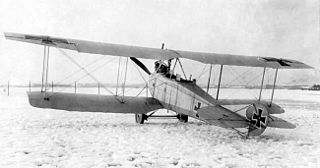
The Aviatik C.I was an observation aircraft which came into service during World War I in April 1915. It was a development of the Aviatik B.I and B.II models, being one of first aircraft of the new German C class of armed biplanes. In the C.I the observer sat in front of the pilot, with a machine-gun clipped on a sliding mounting fitted on a rail at either side of the cockpit. It gave the crew the means to attack enemy aircraft. The positions of the pilot and observer were reversed in last series of 50, ordered in 1917 solely for trainer purpose. There was only one aircraft built of refined C.Ia version in May 1916, with armament still in a forward cab, serving as a prototype for C.III. Later models of the plane included the Aviatik C.II and the C.III, which had more powerful engines. The C.III was produced in large numbers.

The Albatros W.4 was a German floatplane derivative of the Albatros D.I fighter with new wing and tail surfaces of greater span than the D.I. One hundred eighteen examples were built between June 1916 and December 1917. The aircraft operated in the North Sea and Baltic theatres and later served as training aircraft.
Luftverkehrsgesellschaft m.b.H. was a German aircraft manufacturer based in Berlin-Johannisthal, which began constructing aircraft in 1912, building Farman-type aircraft. The company constructed many reconnaissance and light bomber biplanes during World War I.
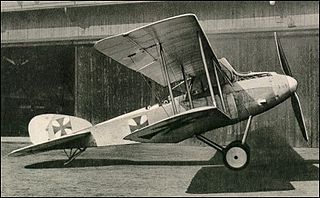
The Albatros C.V was a German military reconnaissance aircraft which saw service during World War I.

The Aviatik B.I is a German two-seat reconnaissance biplane designed and built by the Automobil und Aviatik AG company, who until then had produced copies of French designs.
Automobil und Aviatik AG was a German aircraft manufacturer during World War I. The company was established at Mülhausen in 1909 and soon became one of the country's leading producers of aircraft. It relocated to Freiburg in 1914 and to Leipzig in 1916 and established a subsidiary in Vienna as Österreichisch-Ungarische Flugzeugfabrik Aviatik. During the war, the company became best known for its reconnaissance aircraft, the B.I and B.II, although the Austro-Hungarian subsidiary also produced a number of its own designs, including fighters such as the D.I.

The Hannover CL.III was a German military aircraft of World War I. It was a two-seat multi-role aircraft, primarily used as a ground attack machine. Like the other Hannover "light-C-class", or "CL" designated aircraft designed by Hermann Dorner, it included an unusual biplane tail, allowing for a greater firing arc for the tail gunner. Until the introduction of the aircraft, such tails had only been used on larger aircraft.

The Argus As II was a six-cylinder, in-line, water-cooled, aircraft engine produced in Germany by Argus Motoren in 1914. The Argus As II produced 120 hp (89 kW) at 1,350 rpm.

The Conrad C.III was a six-cylinder, water-cooled inline aircraft engine designed by Robert Conrad. It was used on some German training aircraft during World War I. The engine was mainly produced under license by the German Nationale Automobil Gesellschaft.
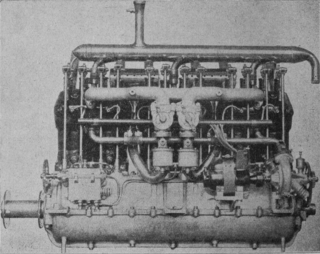
The Argus 115 hp aircraft engine from 1913 was a six-cylinder, water cooled inline engine built by the German Argus Motoren company.

The Argus 140/150 hp 6-cylinder aircraft engine from 1913 was a six-cylinder, water cooled inline engine built by the German Argus Motoren company from 1913 to 1914.
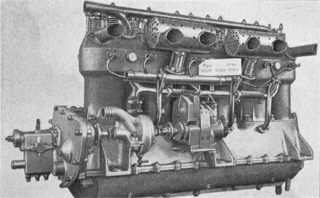
The Argus 110 hp aircraft engine, aka Argus Type III, from 1912 was a six-cylinder, water cooled inline engine built by the German Argus Motoren company.
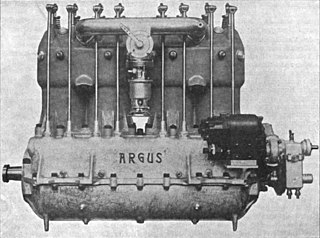
The Argus 140/150 hp aircraft engine from 1911, also known as Argus Type IV, was a four-cylinder, water cooled inline engine built by the German Argus Motoren company.

The Argus 70 hp aircraft engine, aka Argus Type I from 1911 was a four-cylinder, water cooled inline engine built by the German Argus Motoren company. The engine also was license produced in France by Automobiles Rossel and sold in France under the brand names 'Aviatik' and 'Aviatic-Rossel' by Louis Clément, the local sales representative of the Automobil und Aviatik AG.

The Rapp Rp III was a six-cylinder, SOHC valvetrain water-cooled inline aircraft engine built by Rapp Motorenwerke. Its design had been based on the previous Rapp 100 hp four-cylinder engine.
The Rapp 100 hp was a four-cylinder, SOHC valvetrain liquid-cooled inline aircraft engine built by Rapp Motorenwerke. The engine originated from Karl Rapp's earlier 90 hp four-cylinder that he had designed at the Flugwerk Deutschland GmbH for the 1912/13 Kaiserpreis aircraft engine contest.
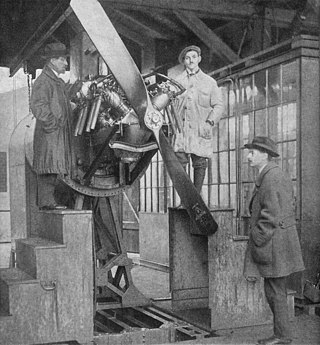
The Rapp 125/145 hp, also referred to as Rapp Rp II, was a water-cooled 90° V-8 aircraft engine built by Rapp Motorenwerke in 1915.


















